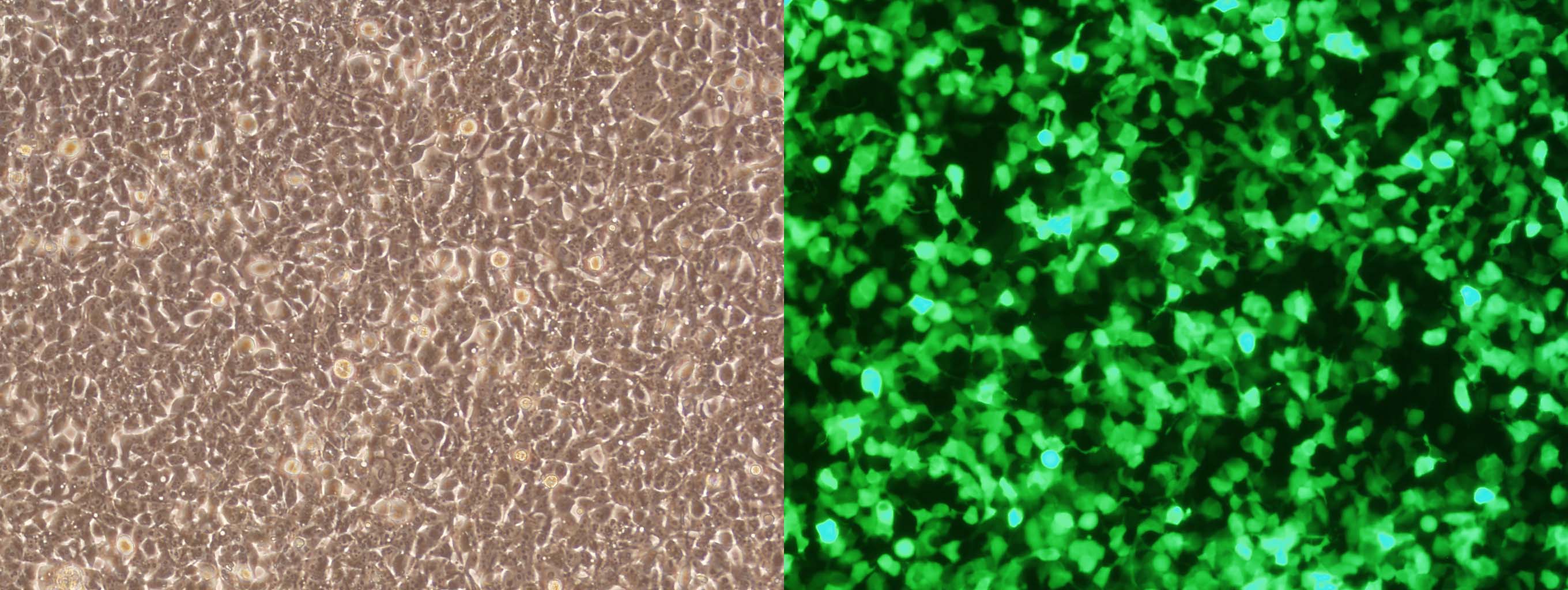Description
Cell to transfect:
Designations: 293T/17 [HEK 293T/17]
Cell Synonyms: : HEK 293T/17, CRL-11268, 293T
Depositors: Rockefeller Univ.
Growth Properties: adherent
Organism: Homo sapiens
Morphology: epithelial
Source: kidney
Antigen Expression: SV40 T antigen [45408]
Age: fetus
Comments: The 293T/17 cell line is a derivative of the 293T (293tsA1609neo) cell line. 293T is a highly transfectable derivative of the 293 cell line into which the temperature sensitive gene for SV40 T-antigen was inserted. 293T cells were cloned and the clones tested with the pBND and pZAP vectors to obtain a line capable of producing high titers of infectious retrovirus, 293T/17. These cells constitutively express the simian virus 40 (SV40) large T antigen, and clone 17 was selected specifically for its high transfectability.
Features of The Transfection Reagent:
- Broad spectrum for the transfection of large plasmid, mRNA, siRNA, and/or other type of nucleic acids, which is best for co-transfection of different type and/or size of nucleic acids.
- Specifically optimized to deliver nucleic acids into 293T/17 Cells
- Highest efficiency to ensure experimental success
- Lowest Cellular Toxicity-maintain cell density and reduce experimental biases
- 0.5 ml is able to transfect about 1000 wells of 24-well plate
- Deliver single or multiple plasmids
- Synthesized from 100% animal origin-free components, making it easy to validate the absence of zoonotic diseases, such as BSE or viruses, in research experiments or cells lines
- Compatible with serum
- Suitable for Reverse Transfection
- Compatible with transfection in any plate format
Data
 FIG. 1. High throughput test of transfection efficiency (determined as RLU/mg) on 293 cells after transfection of luciferase reporter gene by using our 172 proprietary transfection formulas and several most popular commercial transfection reagents. The yellow box showed the results of 4 commercial transfection reagents. The red lines marked our candidate formulas with the highest transfection efficiency for 293 cells. This test result was confirmed with repeat experiments. The candidate formulas were also tested in 293T/17 cells by transfecting GFP expression plasmid, and got the same high transfection efficiency after flow cytometry analysis. The one that showed the optimal balance of potent & low cytotoxicity (percentage of 7AAD positive cells) among those candidate formulas was later named as 293T/17 Cell Avalanche Transfection Reagent.
FIG. 1. High throughput test of transfection efficiency (determined as RLU/mg) on 293 cells after transfection of luciferase reporter gene by using our 172 proprietary transfection formulas and several most popular commercial transfection reagents. The yellow box showed the results of 4 commercial transfection reagents. The red lines marked our candidate formulas with the highest transfection efficiency for 293 cells. This test result was confirmed with repeat experiments. The candidate formulas were also tested in 293T/17 cells by transfecting GFP expression plasmid, and got the same high transfection efficiency after flow cytometry analysis. The one that showed the optimal balance of potent & low cytotoxicity (percentage of 7AAD positive cells) among those candidate formulas was later named as 293T/17 Cell Avalanche Transfection Reagent.
 FIG. 2. 293T/17 cells were transfected with GFP vector (pEGFP-N3) by using 293T/17 Avalanche® Transfection Reagent. The cells were visualized by Nikon Eclipse Fluorescence microscope 24 hours post transfection.
FIG. 2. 293T/17 cells were transfected with GFP vector (pEGFP-N3) by using 293T/17 Avalanche® Transfection Reagent. The cells were visualized by Nikon Eclipse Fluorescence microscope 24 hours post transfection.
For Other Cells
293T/17 Cell Avalanche® Transfection Reagent can also be used on the following cells with high transfection efficiencies.
786-O Cell
Caki-1 Cell
MDCK Cell
Vero Cell
293 Cell
Recommended protocols for these cells will be provided with the reagent. The protocols usually provide satisfactory transfection efficiency with invisible cytotoxicity. However, optimization may be needed for certain type of cells. Optimizations may include: the amount of DNA and this transfection reagent; cell density; transfection reagent/DNA ratio, or incubation time for the mixture of transfection reagent/DNA etc. For best transfection result, we recommend using the respective cell type/cell line specific Avalanche transfection reagents. Those reagents have been optimized on both recipes and protocols, and have been proved to have the best transfection results for the respective cell lines or primary cells. You can easily find the respective Avalanche transfection reagents specific for your cells by using the filters of our product list.
Additional Information
| Weight | 0.5 lbs |
|---|---|
| Adherence Phenotype |
Adherent |
| Cell Type |
Epithelial Cell |
| Disease |
Healthy |
| Names starting from |
0-9 |
| Primary/Cell Line |
Cell Line |
| Product Sizes |
0.5 ml, 1.5 ml |
| Species |
Human |
| Tissue Sources |
Kidney |
| Subcategories |
Cell Type/Cell Line Specific |
Documents
Protocols
MSDS
Citations or Feedback


